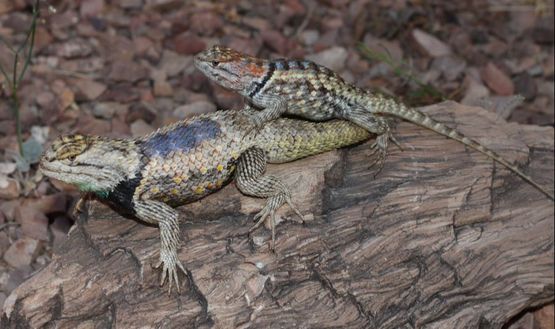Evolution of Sexual Dimorphism
A central goal of evolutionary biology is to explain how complex phenotypes can diverge between the sexes, even though males and females share an autosomal genome. Differentially expressed sex steroids are a major mechanism that might explain this phenomenon, yet we lack a thorough understanding of how these hormones regulate development and how they may facilitate or constrain the evolution of sexual dimorphism. My laboratory studies the evolution of sexual size dimorphism by examining comparative patterns of sex-biased gene expression and the role of testosterone (T) in regulating sex-biased gene expression. We study sexual dimorphism in lizards, which vary in the magnitude and direction of dimorphism in multiple traits, including body size. Our research has documented sex-differences in traits as diverse as predator detection (Curlis et al. 2016) and parasitism (Rosso et al. 2020), revealed that the potential for sexual size dimorphism can be altered by the environment (Curlis et al. 2017), and have discovered that females retain the potential for male-typical expression of dimorphic traits (Cox et al. 2015). We were funded by the NSF in 2018 (1755134) study the evolution of sex-biased gene expression and the response to testosterone. Thus far, this work has revealed that differences in size between the sexes are due to interactions between testosterone and growth regulatory networks (Cox et al. 2017), gene expression changes are responsible for the loss of sexual dichromatism (Robinson et al. in press), interspecific variation in sexual size dimorphism between species can be due to differences in expression of growth-regulatory networks (Cox et al. 2022a), and that both ontogenetic and evolutionary variation in the interactions between regulatory networks can facilitate phenotypic evolution (Cox et al. 2022b; Hale et al. 2022). Our current work examines the molecular evolution consequences of sex-biased gene expression and the relative roles of trans-regulation in facilitating or constraining diversity in body size. This work has been funded by the Physiological Mechanisms and Biomechanics Program in the Division of Integrative Organismal Systems, the Evolutionary Processes Program in the Division of Environmental Biology, and the Rules of Life Venture Fund of the Emerging Frontiers Program in the Directorate for Biological Sciences at the National Science Foundation.
